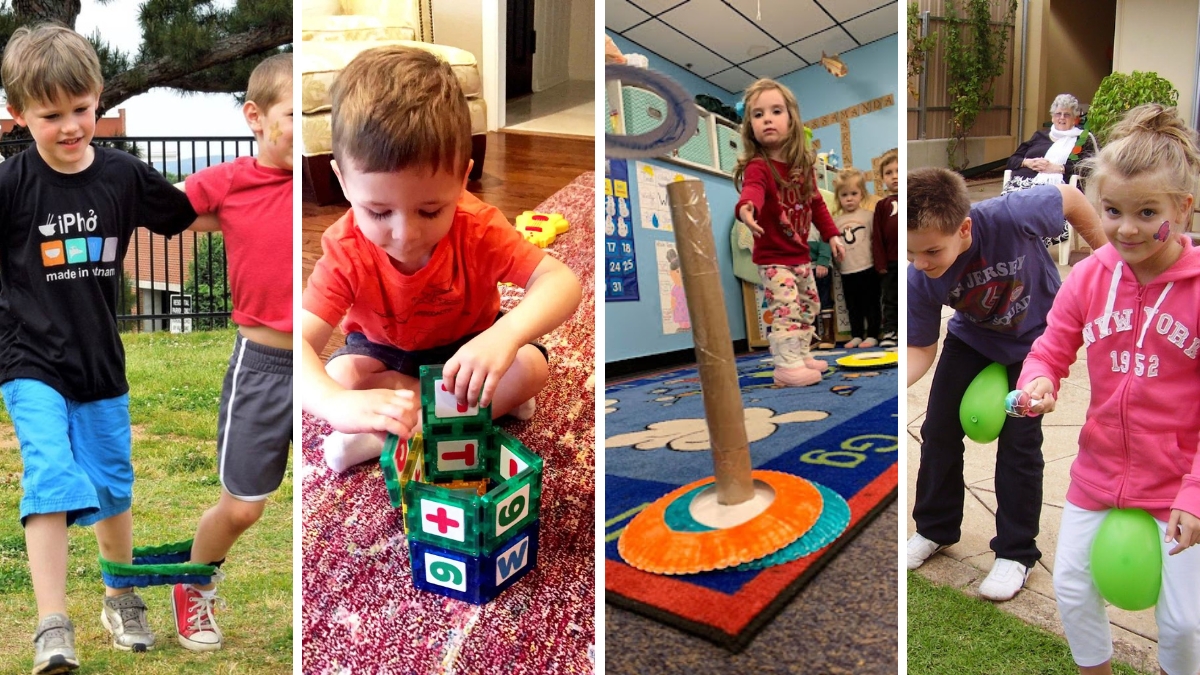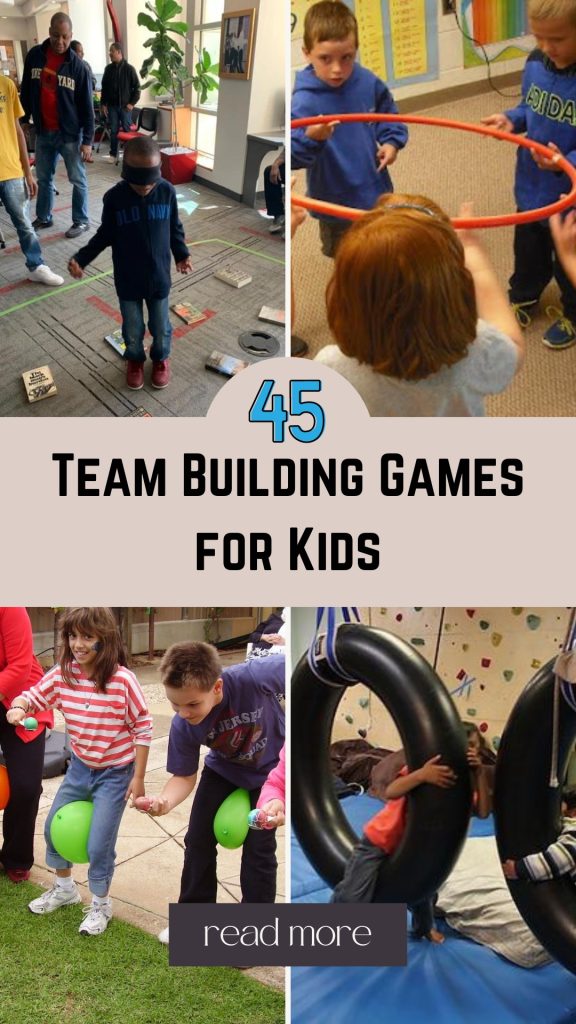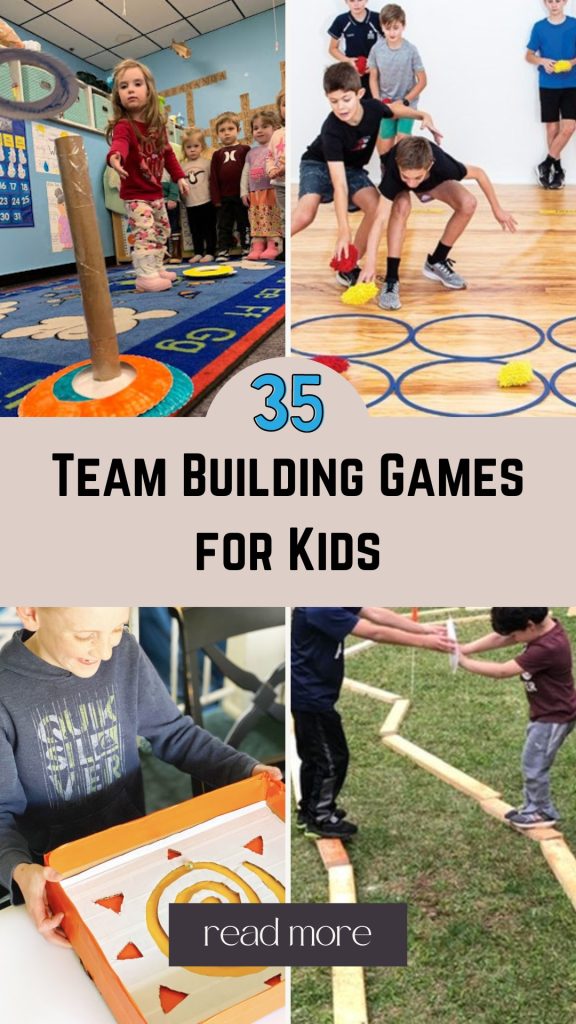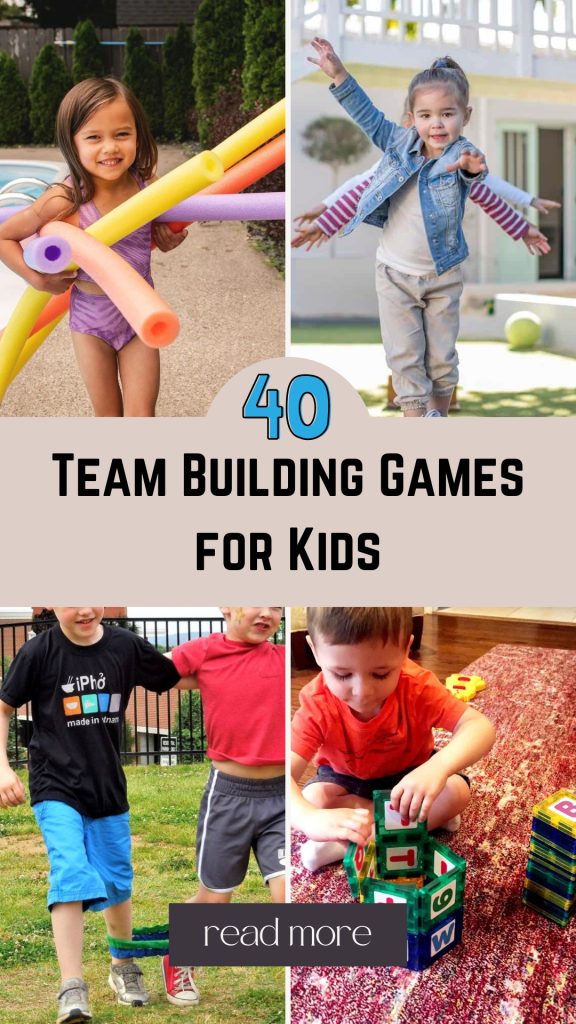45 Team Building Games for Kids in 2025

Team-building games are a great way to bring kids together, helping them build friendships and learn important skills.
In this article, I’ll share 45 exciting team-building games that will keep kids engaged and working together.
Let’s begin!
Contents
- 1 45 Team Building Games for Kids
- 1.1 1. Picture Pieces
- 1.2 2. Get To Know You Balloons
- 1.3 3. Hot and Cold
- 1.4 4. Marshmallow-and-Toothpick Challenge
- 1.5 5. Hula-Hoop Pass
- 1.6 6. Bumpity-ump-bump-bump
- 1.7 7. Snakes
- 1.8 8. Human Tic-Tac-Toe
- 1.9 9. Relay Races
- 1.10 10. Group Juggle
- 1.11 11. Trust Walk
- 1.12 12. Circle Sit
- 1.13 13. Cross the River
- 1.14 14. Floating Hula Hoop
- 1.15 15. Scavenger Hunt
- 1.16 16. Stranded
- 1.17 17. Do Not Wake the Dragon
- 1.18 18. Leaps and Bounds
- 1.19 19. Magnetic Fishing Game
- 1.20 20. Balloon Pop Relay
- 1.21 21. Wheelbarrow Race
- 1.22 22. Triangle Tag
- 1.23 23. Group Juggle
- 1.24 24. Snakes
- 1.25 25. Human Tic-Tac-Toe
- 1.26 26. Relay Races
- 1.27 27. River Crossing
- 1.28 28. Race to the Middle
- 1.29 29. Eye of the Tiger
- 1.30 30. Human Caterpillar Challenge
- 1.31 31. 15 Seconds
- 1.32 32. Race to the Galaxy
- 1.33 33. Roller Coaster
- 1.34 34. Tower Building
- 1.35 35. Pool Noodle Fun
- 1.36 36. Balance Game for Littles
- 1.37 37. Three-Legged Race
- 1.38 38. Triangle Tag
- 1.39 39. Human Caterpillar Challenge
- 1.40 40. Sneak A Peek
- 1.41 41. Cup Stacking Challenge
- 1.42 42. Classification
- 1.43 43. Marble Run Challenge
- 1.44 44. Go!
- 1.45 45. Chuck the Chicken
45 Team Building Games for Kids

1. Picture Pieces
Picture Pieces is a creative and collaborative activity where kids draw individual parts of a larger picture and then assemble them to see the complete image.
First, select a large picture and cut it into smaller pieces, ensuring each piece is simple enough for kids to draw.
Distribute these pieces to the kids along with drawing paper and coloring supplies. Each child receives a piece of the larger image to replicate on their paper.
Once everyone has completed their drawings, they work together to assemble their pieces to form the full picture. This game promotes creativity, teamwork, and a sense of achievement as the group sees their individual efforts come together to create something beautiful.
2. Get To Know You Balloons
This fun activity helps kids learn more about each other through a playful balloon-popping game. You’ll need to provide each child with a balloon and a slip of paper.
Instruct them to write a get-to-know-you question on the paper, place it inside the balloon, inflate it, and tie it off.
Once all balloons are ready, kids gather in a circle and toss the balloons around for a few minutes.
At your signal, each child grabs a balloon, pops it, and reads the question inside aloud. They then answer the question, sharing a bit about themselves.
3. Hot and Cold
Hot and Cold is a classic game that teaches kids to use verbal cues and teamwork to find hidden objects. To play this game; form small groups of three to five kids.
One child from each group leaves the room while the rest select an object in the room to hide. The child who left returns and tries to find the hidden object.
The rest of the group provides guidance by saying “hot” when the seeker is close and “cold” when far away. This continues until the object is found.
4. Marshmallow-and-Toothpick Challenge
You should divide the kids into equal-sized teams and provide each team with an equal number of marshmallows and toothpicks.
Set a timer and challenge the teams to build the tallest, most stable, or most creative structure within the given time.
Each team member takes turns placing marshmallows and toothpicks. At the end, each team presents their structure, explaining their design and how they worked together.
5. Hula-Hoop Pass
To play the Hula-Hoop Pass game; arrange the kids in a circle and have them hold hands. Place a hula hoop on one child’s arm.
The objective is to pass the hula hoop all the way around the circle without letting go of each other’s hands.
Kids must figure out how to maneuver their bodies through the hula hoop and pass it along. This game enhances coordination, communication, and teamwork.
6. Bumpity-ump-bump-bump
If you want to play this game; you should have the kids form a large circle with one child standing in the middle.
The child in the middle walks around the inside of the circle, stops in front of someone, and gives a direction (left, right, self, or it).
The chosen person must quickly say the correct name (person to their left, right, their own name, or the person in the middle) before the leader finishes saying “bumpity-ump-bump-bump.”
If they fail, they become the new leader. This game builds quick thinking, memory, and helps kids learn names in a fun way.
7. Snakes
You should divide kids into teams and blindfold all but one member of each team. Scatter soft objects around the play area.
The sighted team member stands at the back and gives non-verbal directions by tapping shoulders to guide the blindfolded team members.
The goal is to collect all the objects and place them in a designated spot. This game promotes trust, non-verbal communication, and cooperation.
8. Human Tic-Tac-Toe
In this life-sized version of tic-tac-toe, kids are the game pieces, and they work together to form lines of X’s or O’s.
First, you should create a tic-tac-toe grid on the ground using tape or chalk and divide the kids into two teams.
Teams take turns placing their members in the grid to form a row of three. Kids must strategize and communicate to block the other team and complete their own lines.
9. Relay Races
You should set up a race course with different stations, each with a specific task like dribbling a ball, running through cones, or carrying an egg on a spoon. Divide kids into teams and have them line up at the start.
At your signal, the first player completes the task at the first station and then tags the next player, who does the same at the next station.
This continues until all team members have completed the course. The first team to finish wins.
10. Group Juggle
First, you should have the kids form a circle and start with one ball. Gradually increase the number of balls as they get better.
The game starts with one child throwing a ball to another, calling out their name as they do. The receiver then throws the ball to someone else, calling out their name, and so on.
As the group gets comfortable, introduce more balls to increase the challenge. This game helps kids learn names, improve hand-eye coordination.

11. Trust Walk
To set up, you should create an obstacle course using various objects like cones, chairs, or ropes. Mark a start and finish line.
Divide kids into pairs; one child is blindfolded while the other acts as a guide. The guide uses only verbal instructions to help their partner navigate through the obstacles without touching them.
12. Circle Sit
To play this, you should gather a group of children and have them form a tight circle, standing close together.
Ask everyone to turn 90 degrees to their left, so they are facing the back of the person in front of them.
On your signal, the children slowly sit down, attempting to sit on the lap of the person behind them, creating a human chain of seated support.
If done correctly, everyone will be sitting on each other’s laps, supported by the group. This game emphasizes the importance of working together and relying on one another.
13. Cross the River
You should use tape or chalk to draw two parallel lines on the ground, representing the riverbanks. Provide each team with a limited number of cardboard pieces or “rafts.”
The objective is for the entire team to cross the river by stepping only on the rafts without touching the ground.
Players must strategize and work together to move the rafts and ensure everyone gets across safely. If anyone steps off the raft onto the ground, the team must start over.
14. Floating Hula Hoop
Floating Hula Hoop is a simple yet effective game for building communication and teamwork. Arrange children in a circle, standing close together.
Each participant holds the hula hoop using only their fingertips. The goal is to lower the hula hoop to the ground without letting it drop or losing contact with it.
The children must work together, communicating and adjusting their movements to ensure the hula hoop stays level and descends slowly.
15. Scavenger Hunt
You should first prepare a list of items for the kids to find and hide them around a designated area, either indoors or outdoors.
Divide the children into teams and provide each team with the list of items. The teams must work together to find all the items on the list within a set time limit.
Clues or riddles can be provided to guide the teams. This game promotes teamwork, enhances problem-solving abilities, and keeps kids engaged.
16. Stranded
You should mark off a corner of the room as a “deserted island” and place a few children there. The rest of the group stands at a designated “ship” area, 10-15 feet away.
The goal is to rescue the stranded kids using only items available to them, like shoelaces, jackets, and paper.
The rescuers must create a line long enough to reach the island and pull their teammates to safety.
17. Do Not Wake the Dragon
Designate one child as the “dragon” who pretends to sleep on one side of the room. The rest of the children, acting as villagers, must complete a task like lining up by birth month or height without making any noise to avoid waking the dragon.
Once the task is complete, they yell to wake the dragon, who then tries to tag as many villagers as possible before they reach a safe zone.
18. Leaps and Bounds
You should create a pretend river using a sidewalk or gym floor and place stepping stones (e.g., pieces of cardboard or mats) across it.
Children take turns jumping from stone to stone to cross the river. If a player falls off a stone, they are out of the game.
As kids become more confident, increase the difficulty by spacing the stones farther apart.
19. Magnetic Fishing Game
You should fill a kiddie pool with water and place magnetic fish inside. Provide each child with a magnetic fishing rod.
The objective is to catch as many fish as possible within a set time. Children take turns using the rods to attract and catch the fish.
This game can be played individually or in teams, with the team or individual catching the most fish declared the winner.
20. Balloon Pop Relay
To play Balloon Pop Relay you should inflate several balloons and place them in a straight line. Divide the children into equal teams and position them at checkpoints along the relay path.
The first player from each team starts by running to the first balloon, sitting on it to pop it, and then running back to tag the next player.
The relay continues until all balloons are popped. The team that finishes first wins.

21. Wheelbarrow Race
To set up, pair the children and assign one to be the “wheelbarrow” and the other the “pusher.” You will need an open space and markers to define the start and finish lines.
The child acting as the wheelbarrow walks on their hands while the pusher holds their legs. At the signal, each pair races to the finish line.
The game requires communication and coordination between the partners to maintain balance and speed.
The first pair to cross the finish line wins. Ensure safety by supervising to prevent falls and encouraging participants to go at a comfortable pace.
22. Triangle Tag
First, form groups of four, with three players holding hands to create a triangle and one player acting as the tagger. Designate a safe playing area free of obstacles.
The tagger’s goal is to tag one specific player in the triangle, while the other two players work to protect them by moving and turning the triangle.
The players in the triangle must communicate and cooperate to shield the targeted player from the tagger.
23. Group Juggle
Arrange the children in a large circle and start with one ball. If the group is large, additional balls can be introduced to increase the challenge.
Each child says their name and throws the ball to someone else in the circle, calling out the recipient’s name before throwing.
As the game progresses, more balls are added, making it more challenging to keep track of names and balls.
24. Snakes
You should divide the kids into small groups, with one child being the guide and the others blindfolded and forming a line by holding onto the shoulders of the person in front of them.
The guide leads the blindfolded “snake” to collect items scattered around the play area without using words.
The snake must navigate obstacles and gather as many items as possible within a set time.
25. Human Tic-Tac-Toe
First, mark a large 3×3 grid on the ground using tape or chalk. Divide the children into two teams, assigning each team either X or O.
Teams take turns having one player stand in a grid square to claim it for their team. The objective is to form a line of three team members horizontally, vertically, or diagonally.
This game requires coordination and strategy as teams plan their moves to block the opposing team while trying to form their own line.
26. Relay Races
Set up a course with a clear start and finish line and define various challenges or stations along the way, such as running through cones, dribbling a ball, or carrying an object.
Divide the children into teams, with each team member completing a leg of the race and passing a baton or touching hands to the next runner.
The team that completes the course first wins. Relay races encourage cooperation, speed, and endurance while adding fun and excitement.
27. River Crossing
You should create two parallel lines on the ground to represent the river banks and provide large cardboard pieces or mats to serve as rafts.
Teams must cross the river by stepping only on the rafts, which can only hold a certain number of players at a time. If a raft is left unattended, it “floats away.”
The game requires careful planning and cooperation as teams strategize to get all members across without losing any rafts.
28. Race to the Middle
Place a series of objects or markers in a central location. Divide the children into two teams and position them at equal distances from the center.
At the signal, one player from each team races to the middle, grabs an object, and returns to their team.
The next player then goes, and the race continues until all objects are collected. The team with the most objects at the end wins.
29. Eye of the Tiger
Divide the children into two teams and provide each team with different-colored shirts or pinnies. Establish ground rules and set up a safe playing area.
Teams must work together to complete a series of physical challenges, such as balancing, jumping, or carrying objects, while maintaining their formation and not getting “tagged” by the other team.
30. Human Caterpillar Challenge
Arrange the children in a single line, each holding the waist of the person in front. The goal is to move as a single unit, similar to a caterpillar.
Teams must navigate a course, complete with turns and obstacles, without breaking their formation. If the line breaks, they must start over.
This game promotes physical coordination and cooperation, as children must move in sync and communicate effectively to stay together.

31. 15 Seconds
To set up, gather all players in a circle with one child designated as the leader. The leader selects a topic, such as favorite animals or holiday activities.
Each child has 15 seconds to answer a question related to the topic when it’s their turn. The leader ensures everyone adheres to the time limit and keeps the game moving.
This game enhances quick thinking and verbal skills, while also being a lot of fun.
32. Race to the Galaxy
To play, divide the children into teams and give each team three hula-hoops. Lay out bean bags in various colors scattered around the play area.
Each team must work together to travel across the “galaxy” (the play area) using their hula-hoops as ships, without touching the ground.
They can only move by stepping inside the hula-hoops. The objective is to collect all their color-coded power sources and return to the starting point.
33. Roller Coaster
Have the children sit on the ground in a straight line, legs outstretched and touching the heels of the person in front of them.
The leader stands in front and gives instructions like “climb up” (move hands up), “swoosh down” (lean back), and “turn left/right” (lean to the side).
The kids follow these directions, mimicking the movements of a roller coaster. This game enhances listening skills and coordination.
34. Tower Building
Divide the children into teams and provide each team with a set of building blocks and a die. Teams take turns rolling the die, with the number rolled indicating how many blocks they can add to their tower.
The goal is to build the tallest tower within a set time limit. This game encourages cooperation, strategic planning, and fine motor skills.
35. Pool Noodle Fun
To play the Pool Noodle game; you should divide the kids into small groups and give each group two pool noodles and a ball.
The objective is to keep the ball balanced on the noodles as they navigate through a series of instructions given by the leader, such as walking in a straight line, turning around, or moving in a zigzag pattern.
This game helps improve balance, coordination, and teamwork. It’s perfect for outdoor play and can be set up quickly with minimal equipment.
36. Balance Game for Littles
In the Balance Game for Littles, pairs of kids balance a lightweight ball on a piece of paper between them and race to place it in a basket at the other end of the room.
To set up, give each pair a piece of paper and a ball. They must hold the paper tautly between them, ensuring the ball doesn’t fall off as they move towards the basket.
37. Three-Legged Race
The Three-Legged Race is a classic outdoor activity where pairs of kids have their adjacent legs tied together and must race to the finish line.
To set up, pair up the children and use ties or scarves to bind their legs together. Mark a starting line and a finish line.
On the signal, pairs race towards the finish line, coordinating their steps to avoid falling. This game is excellent for promoting teamwork, coordination, and physical activity.
38. Triangle Tag
To play, form groups of three with one player in the center. The other two players form a triangle around the center player by holding hands or using soft ropes. The tagger tries to tag the center player while the outer players move to shield them.
This game requires quick thinking, agility, and coordination as teams work together to prevent the tagger from reaching the center player.
39. Human Caterpillar Challenge
The Human Caterpillar Challenge involves teams forming a caterpillar by linking arms and racing to the finish line.
To set up, divide the kids into teams and have them stand in a line, linking arms. The teams must move together, staying linked, to reach the finish line.
The first team to cross the line without breaking their caterpillar formation wins. This game emphasizes communication, coordination, and teamwork.
40. Sneak A Peek
In the Sneak A Peek; teams recreate a structure using building blocks. To set up, create a simple structure with building blocks in a separate area.
Teams take turns sending one member to “sneak a peek” at the structure for ten seconds before returning to describe it to their teammates, who then attempt to recreate it.
If the structure isn’t correct, another team member takes a peek and provides more guidance.

41. Cup Stacking Challenge
To set up, divide the kids into teams of five and provide each team with six paper cups, a rubber band, and five pieces of string.
Each team member ties their string to the rubber band, creating a tool for manipulating the cups.
The objective is to stack the cups into a pyramid structure without directly touching them, using only the strings and rubber band.
42. Classification
To play this, divide the children into two or three groups and give them a few minutes to share information about themselves, such as their favorite foods, hobbies, or dreams.
Based on this information, ask them to classify themselves into sub-groups without using any negative stereotypes or judgments. For example, groups could be formed based on favorite colors or types of pets.
43. Marble Run Challenge
You should provide each team with a variety of materials such as cardboard tubes, tape, scissors, and marbles.
The objective is for each team to design and build a track that will transport a marble from the start to the finish line.
Set a time limit for the construction phase and then test each team’s marble run to see whose marble reaches the end the fastest or in the most creative way.
44. Go!
In this game; players stand in a circle and must communicate using only eye contact to coordinate their movements.
The facilitator shouts “Go!” and the players must move around, trying to reach a designated point or complete a task without speaking.
This game teaches children the importance of body language and non-verbal cues in communication.
It also helps them develop better focus and coordination as they work together to achieve a common goal.
45. Chuck the Chicken
To play, divide the children into two teams. Each team takes turns tossing a rubber chicken as far as possible.
While the opposing team runs to retrieve the chicken and form a line behind the player holding it, the throwing team runs in a circle around a designated point, counting their laps until the chicken is retrieved.
The objective is to see which team can accumulate the most laps in their turn. This game promotes teamwork, quick thinking, and physical exercise.

Fasial is the founder of the Fizzy Flare. He has been a passionate blogger since 2021. He ran three different websites in the past few years. Now he is focusing on Fizzy Flare to build an audience and help them organize their life.
